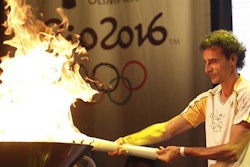
Dr. João Grangeiro has a fine Olympic pedigree. He's been involved in six Summer and three Winter Olympic Games, first representing Brazil at volleyball and then working as an orthopedic specialist. But his greatest challenge to date will come from 5 August to 18 September, when Rio 2016 Olympics takes place.
As chief medical officer of the Organizing Committee for the Olympic and Paralympic Games, Grangeiro is overseeing the 3,500 square meter polyclinic that has impressive imaging, dental, ophthalmology, pharmacy, and clinical therapy facilities. He will be in charge of doctors from many different specialties, from sports medicine and radiology to physiotherapy and dermatology.
 Dr. João Grangeiro has participated in nine Olympic Games. Image courtesy of Rio 2016.
Dr. João Grangeiro has participated in nine Olympic Games. Image courtesy of Rio 2016.Grangeiro attended London 2012 and he quickly realized that he needed to expand the imaging section, according to Dr. Phil O'Connor, imaging lead at London 2012.
"He was attempting to run the imaging service on one MRI scanner, with no CT, no x-ray, no MSK (musculoskeletal) ultrasound. He spent two days with us in London, and then said he would have two MRIs, a CT, and ultrasound machines!" O'Connor told AuntMinnieEurope.com. "There's a lot of budgetary pressure to get the cost of imaging down, but with the level of athletes you're dealing with and the importance of the competition, you've got to provide them with the imaging they need."
During the London games, up to 59 MR exams were performed on each day. Scanning started at 7 a.m., but polyclinic staff had to arrive at 6 a.m. The Brazilians will be much better informed about the workload, type of injuries, etc., because O'Connor and his team have documented their experiences rigorously in research papers and other reports.
"We captured an entire Olympic Games. No athlete left the village to go for a scan elsewhere," he said. "It was the first time in history that the American team didn't get their scans second-reported in the U.S."
O'Connor is unsure what will happen in Rio, however. At the Beijing 2008 Games, for example, Team GB set up a medical facility in Macau and had a radiologist on site for second reporting, and he suspects a similar arrangement will exist for the 2016 games.
Electronic records
In addition to the two MRI systems, the polyclinic in Rio will be equipped with wireless digital x-ray systems and ultrasound scanners to provide high-quality images, as well an electronic medical record (EMR) system that will aid the management of, and access to, medical images and clinical data by medical staff.
The addition of this EMR system is already proving to be a game changer in the sports medicine field.
 MRI will play an integral role at Rio 2016. Image courtesy of GE Healthcare.
MRI will play an integral role at Rio 2016. Image courtesy of GE Healthcare."I think the EMR is a big step forward for the games," Grangeiro told the Pulse magazine from GE Healthcare. "In the past, we relied on patchy records and the medical encounters we already had with the athletes. Now, we have the chance to have all their previous imaging data and records on the same digital file and in a cloud system that we can access anywhere; the way we manage patients is going to be much more efficient."
To be a successful doctor at the Olympics, it's essential to have up-to-date knowledge, he explained.
"You need to know how your athletes are training, what they are doing, how they are doing it, what their physical and mental state is. You need to be involved in what they are eating, how they are sleeping, and a whole list of other factors. It's really a doctor-patient relationship unlike any other," said Grangeiro, who was an athlete in the 1980 Moscow games and played volleyball for his national team for about five years, before working as a doctor at the Barcelona games in 1992.
To make all this possible, doctors must have the utmost confidence in their work. "That would be my main advice for doctors joining or willing to join the Olympic Games medical team: Do your best for your athletes to be confident in your abilities," he added.
Legacy of Rio
Legacy will be an important issue, as always at the Olympics. For Grangeiro, the games will give a much-needed boost to Brazil's healthcare system. The polyclinic itself is not a permanent construction, but other gifts will benefit patients for many years to come.
More than $2 million U.S. (1.8 million euros) in new medical devices will be donated to Souza Aguiar Hospital, including four robotic surgical arms, six surgery monitors, six anesthetic machines, three digital x-ray scanners, one CT scanner, three ultrasound units, and software to securely store and manage patients' scans.
The hospital lies in the heart of Rio, and is Latin America's second-largest emergency care center and the city's busiest trauma hospital. It has more than 600 beds and sees in excess of 7,500 patients each month.
 Equipment worth more than $2 million U.S. (1.8 million euros) will be donated to the Souza Aguiar after the games.
Equipment worth more than $2 million U.S. (1.8 million euros) will be donated to the Souza Aguiar after the games.The games organizers hope the surgical arms will help doctors perform 30% more surgeries and cut waiting times, and the aim is for the imaging devices to double the number of CT, ultrasound, and x-ray examinations carried out at the hospital and perform them with less radiation. The anesthetic machines and surgical monitors will help shorten patients' stay in hospital by up to two days by optimizing doses of anesthesia for each patient.
At London 2012, most of the equipment used was purchased by the InHealth Group, including a GE Discovery MR750w wide-bore 3-tesla MRI scanner, an Optima MR450w wide-bore 1.5-tesla MRI scanner, two VENUE 40 ultrasound machines, one LOGIQ E9 ultrasound system, one Dinamap Carescape V100, three Dash 2500 monitors and one Discovery XR656 digital radiography x-ray system.
Health risks from Zika
There is a very low or no risk of visitors catching the Zika virus in Rio this year, the organizers have insisted. Travel to Rio during the games will represent less than 1% of all travel to Zika-infected areas, so if the games were not to happen or if they were postponed, 99% of the risk of Zika would continue to spread across the world because of general international travel, they stated. For every one million tourists, an average of 1.8 people will be affected, which is equal to one case of Zika out of the 500,000 visitors expected to be in the city during the games.
As for the spread of Zika via sexual contact, it is important to clarify that it is already a policy of the International Olympic Committee at every edition of the games to act in conjunction with health authorities in order to prevent the spread of sexually transmitted infections, and this concern has existed long before Zika, the organizers noted.
To read an interview with Grangeiro on the official Rio 2016 website, click here.



















